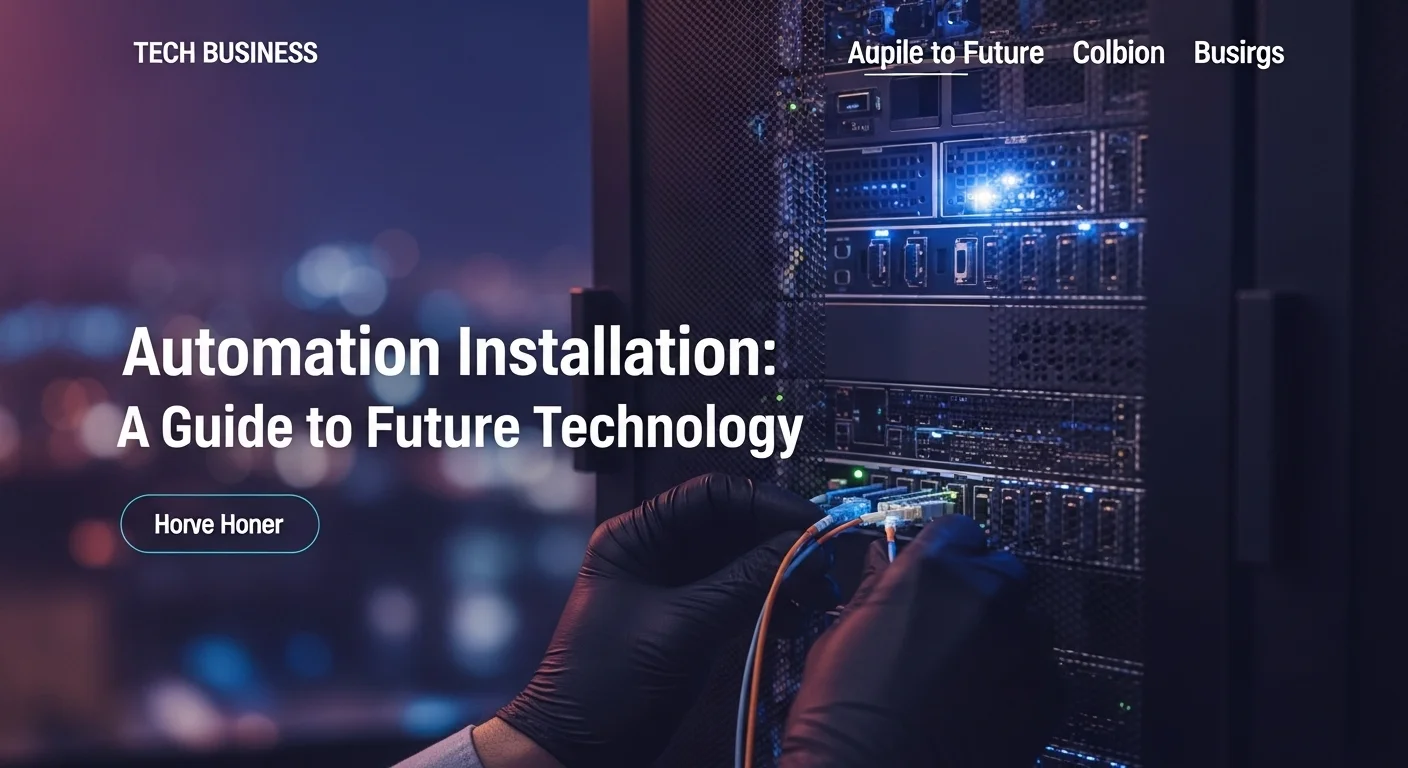Your Guide to Automation Installation: From Smart Homes to Smarter Business

Executive Summary
I've spent years helping people and businesses navigate the world of automation, and I've seen firsthand how it can transform everyday life and work. It's not just about futuristic robots; it's about making your home more comfortable and your business more efficient, right now. This guide is my way of sharing what I've learned. We'll cut through the jargon and talk about what automation installation really means, from large-scale business systems to the smart home you've been dreaming of. I'll show you how automation can slash costs and boost productivity for your company and how it can bring incredible convenience, security, and energy savings to your home. We'll go through the entire process together—planning, picking the right gear, and getting it installed and maintained. Whether you're a business leader looking for an edge or just someone curious about building a smarter home, this guide will give you the practical knowledge you need to get started.
Table of Contents
Table of Contents
- What is Automation Installation and Why Does It Matter?
- A Complete Guide to Installing Your Automation System
- Pro Tips for a Secure and Optimized Automation Experience
What is Automation Installation and Why Does It Matter?
When people hear 'automation,' they often picture one of two things: a huge factory floor with robotic arms, or a sci-fi smart home that talks back. In my experience, the truth is it's both, and so much more. Simply put, 'Automation Installation' is the process of setting up technology to do a job on its own, without you having to push a button every time. It’s been around for a while, but with today’s AI, robotics, and the Internet of Things (IoT), it's become smarter and more accessible than ever. At its heart, automation is about using tech to handle tasks, whether it’s building a car or just turning your lights on at sunset. The 'installation' is where the magic happens—it’s the moment a plan becomes a real, working system.
The impact of this technology is huge. It’s one of the biggest drivers of efficiency I’ve seen in my career. By letting machines handle the repetitive, boring stuff, we humans get to focus on what we do best: creative problem-solving, strategic thinking, and connecting with each other. This doesn't just make a business more productive; it actually makes jobs more interesting. Plus, automated systems are incredibly precise. They don’t get tired or make typos, which means better quality work and fewer costly mistakes. This level of reliability is a game-changer everywhere, from finance, where one wrong number can be a disaster, to manufacturing, where every product needs to be perfect.
The Evolution and Types of Automation
Automation isn't a one-size-fits-all solution. It's evolved into different forms, and each requires a different approach to installation.
1. Industrial Automation
This is the classic powerhouse of automation. Think assembly lines with robotic arms, conveyor belts, and sensors that check quality, all working in perfect sync. Installing this kind of system is a massive project, requiring specialized engineers to design and integrate everything. The payoff is huge: lower costs, safer workplaces, and incredibly fast production.
2. Business Process Automation (BPA)
BPA is automation for the office. It's not about physical robots, but about streamlining workflows and information. I've helped companies set up systems that automate everything from customer service chatbots to employee onboarding. Installing BPA means integrating software and rethinking how teams work with technology to become faster and more data-driven.
3. Robotic Process Automation (RPA)
Think of RPA as a team of digital assistants. These software 'bots' are designed to perform the repetitive digital tasks that eat up so much of our time—logging into apps, copying and pasting data, filling out forms. What’s great about RPA is that it’s often easier to install because it works with the software you already have. It's a quick way to boost productivity and let your team focus on more important work.
4. Home Automation
This is where automation gets personal, and it's where I see the most excitement from people. The 'smart home' is all about connecting devices in your house so you can control them from anywhere. A smart home automation installation can be as simple as a smart thermostat you install yourself or as complex as a fully integrated system controlling lighting, security, and entertainment. For those bigger projects, people often search for 'home automation installation near me' to find a professional. As one of those professional home automation installers, I can tell you that a well-designed system feels effortless. From a sophisticated lighting automation installation that sets the perfect mood to automated locks that give you peace of mind, the benefits in convenience, security, and energy savings are immense.
Business Applications and Benefits
For any business today, automation isn't just a cool tech upgrade—it's essential for survival and growth. The advantages are clear and measurable.
- Cost Reduction: Less manual labor means lower operational costs. The initial investment pays for itself over time.
- Increased Productivity: Machines can work 24/7 without a coffee break. I've seen production rates double after a well-executed automation project.
- Enhanced Quality: Automation eliminates human error in repetitive tasks, leading to consistently high-quality results and happier customers.
- Better Decisions: These systems produce a ton of data. When you analyze it, you get incredible insights that help you make smarter business choices.
- Easy Scalability: Need to handle more orders? An automated system can scale up without you having to hire a whole new team.
- Improved Safety & Security: In factories, robots can handle dangerous jobs. At home or in the office, a professional smart home automation installation can create a powerful security network with cameras, locks, and sensors that are always on guard.
Embarking on an automation journey, whether it’s a company adopting RPA or a family searching for 'home automation installation near me,' starts with a clear goal. A successful home automation system installation is one that feels like it was designed just for your lifestyle, making every day a little bit easier and more secure.

A Complete Guide to Installing Your Automation System
From my experience, a great automation setup, whether for a huge company or your family home, all comes down to a smart plan and careful execution. This isn't just about plugging things in; it's about building a system that truly works for you. Let’s walk through the key steps to make your automation installation a success.
Phase 1: Planning and Assessment
Before you buy a single gadget, we need a solid foundation. This planning stage is the most important part of the entire project.
1. Figure Out Your 'Why'
First, what do you want to achieve? A business might want to cut operational costs by 15%. A homeowner might want to feel safer or save on their energy bill. You need to have clear, measurable goals. I always ask my clients: What are the most annoying, repetitive tasks you do? Where do mistakes happen most often? Answering these questions helps us focus your investment where it will make the biggest difference.
2. Set a Realistic Budget
Automation projects can cost anything from a few hundred dollars to millions. Be realistic about what you can spend. For a business, this means doing a Return on Investment (ROI) analysis. How much will you save in labor versus the upfront cost? For a home project, it's more about personal value, but you still need to weigh the cost against the benefits. Don't forget to account for potential hidden costs like monthly subscriptions or future upgrades.
3. Plan for the Future
Technology changes in the blink of an eye. The last thing you want is a system that's outdated in a few years. I always advise choosing systems that are modular and can grow with you. Maybe you start with a simple lighting automation installation today, but you might want to add smart blinds and security cameras later. For homes, looking for products that support open standards like Matter is a great way to ensure your future devices will all play nicely together.
Phase 2: Choosing the Right System and Technology
With a plan in hand, it's time to pick your gear. This can feel overwhelming, but it boils down to a few key choices.
1. DIY vs. Professional Installation
This is a big question, especially for home automation. DIY solutions from brands like Google and Amazon are fantastic for simple setups. But if you're dreaming of a truly seamless home automation system installation where everything works together flawlessly, hiring a pro is often the best move. It's why so many people search for 'home automation installation near me'. Professional home automation installers like me have the tools and experience to handle complex wiring, ensure your network is rock-solid, and make devices from different brands communicate as one.
2. Understanding How Devices Talk
Smart devices need a way to communicate. Here are the main languages they speak:
- Wi-Fi: It's everywhere and it's fast, making it great for things like security cameras. The downside is that too many Wi-Fi devices can clog up your network.
- Bluetooth: Perfect for short-range connections, like setting up a new device with your phone.
- Zigbee and Z-Wave: These are my go-tos for most smart home devices. They create their own low-power mesh network, separate from your Wi-Fi, which makes them super reliable for things like sensors, locks, and lights.
- Matter: This is the new kid on the block, and it's a big deal. Backed by all the major tech companies, Matter promises to let devices from different brands work together effortlessly. Choosing Matter-certified gear is the smartest way to future-proof your home.
3. Centralized vs. Decentralized Systems
Think of this as having a 'brain' for your system. A centralized system uses a main hub or controller to manage everything. This approach is powerful and simplifies control. A decentralized system relies more on the cloud, with each device connecting to the internet individually. It's simpler to set up but can be less reliable if your internet goes down.
Phase 3: The Installation Process
This is where we get our hands dirty and bring the system to life.
1. Preparation and Pre-wiring
If you're building a new home or doing a major remodel, pre-wiring is a lifesaver. Running the right cables to key locations for cameras, touchscreens, and access points ensures the most stable system possible. Even in an existing home, a good installer knows how to run wires discreetly.
2. Device Installation and Configuration
Next, we physically install each device—swapping out a light switch for a lighting automation installation, mounting a camera, or wiring a thermostat. Then, we connect each one to the network and configure its settings in the control software.
3. Programming the 'Magic'
This is where the real 'automation' in a smart home automation installation happens. We create rules and scenes that fit your lifestyle. For example:
- A 'Good Morning' scene that slowly fades up your lights, opens the blinds, and plays the news when your alarm goes off.
- A 'Movie Night' scene that dims the lights and turns on your TV with a single command.
- An 'Away' mode that arms your security, turns off lights, and saves energy.
4. Testing, Testing, and More Testing
Once everything is programmed, I test it relentlessly. Every rule, every scene, every device. I check for network glitches and programming bugs. A professional home automation system installation isn't finished until the system is 100% stable and reliable. That's the difference between a collection of gadgets and a truly smart home.

Pro Tips for a Secure and Optimized Automation Experience
Alright, your system is installed. But don't just set it and forget it. To get the most out of your investment, you need to think about long-term optimization and security. Here are the tips I give all my clients to make sure their setup stays secure, efficient, and actually makes their lives easier.
Best Practices for Security and Privacy
Every smart device you add to your network is another potential door for cyber threats. Locking down your automated world is not optional; it's essential.
1. Fortify Your Network
Your Wi-Fi router is the front door to your digital home. The first thing you should do is change the default administrator password to something strong and unique. Make sure you're using WPA3 encryption. I also strongly recommend setting up a separate guest network. This keeps visitors' devices off your main network where your sensitive smart home gear lives. For ultimate security, a dedicated network (VLAN) just for your IoT devices is the gold standard.
2. A Unique Password for Everything
Every single device and app in your system needs its own complex password. I know it's a pain, but using a password manager makes it easy. And please, enable two-factor authentication (2FA) everywhere you can. That extra code sent to your phone is one of the best defenses you have.
3. Keep Everything Updated
Manufacturers constantly release software updates to patch security holes. Set your devices to update automatically whenever possible, but still make it a habit to check for updates manually every now and then. An out-of-date device is a vulnerable device.
4. Be Smart About Your Data
Smart devices, especially cameras and speakers, collect data. Take a moment to understand what information each device is gathering. Go into the settings and limit data collection to only what's necessary. When you're looking for 'home automation installation near me,' a good question to ask potential home automation installers is how they approach client privacy and data security.
Optimization and Advanced Strategies
The basic setup is just the beginning. The real magic of automation comes from making it truly intelligent.
1. Let AI Do the Heavy Lifting
Modern systems use Artificial Intelligence (AI) to learn your habits. A smart thermostat, for example, can learn your schedule and automatically create an efficient heating and cooling plan. Security cameras can use AI to tell the difference between a person and a stray cat, cutting down on false alarms. Lean into these features to make your system smarter over time.
2. Create Powerful Scenes
Think beyond just turning things on and off. A 'Goodbye' scene can do more than just turn off the lights—it can lock the doors, arm the security system, and even check if you left the garage door open. A great lighting automation installation can be tied to motion sensors and the time of day, adjusting the brightness automatically. The goal of a top-tier home automation system installation is for the technology to blend into the background, working for you without you even thinking about it.
3. Become an Energy Saver
Automation is a fantastic tool for cutting your utility bills. Use smart plugs to kill 'vampire power' from electronics on standby. Link your smart blinds to your thermostat; on a hot day, they can close automatically to block the sun and ease the load on your AC. An effective lighting automation installation ensures lights aren't left on in empty rooms. These small tweaks add up to big savings.
4. Perform Regular Health Checks
Just like a car, your automation system needs the occasional tune-up. Check batteries in your sensors, clean camera lenses, and make sure your Wi-Fi is strong in every corner of the house. If you hired professional home automation installers, ask them about a maintenance plan. It can be a worthwhile investment to keep your system running perfectly.
Finding Quality Resources and External Links
The world of automation is always changing. Staying informed helps you get the most out of your system. If you really want to geek out and understand the engineering principles behind all this, the best resource I can point you to is the International Society of Automation (ISA). Their site is a goldmine of technical info. You can dive deeper at www.isa.org. This kind of knowledge helps you move beyond a simple smart home automation installation and truly master the technology. By combining a secure, well-maintained system with smart programming, you can turn a standard installation into an experience that genuinely improves your life.
Expert Reviews & Testimonials
Sarah Johnson, Business Owner ⭐⭐⭐⭐
As a small business owner, I found the breakdown of BPA and RPA really helpful. I would have loved a few more case studies on how businesses like mine implemented these ideas.
Mike Chen, IT Consultant ⭐⭐⭐⭐⭐
Solid overview. It clarified the differences between Zigbee and Z-Wave for me. The technical guide in Part 2 was exactly what I needed.
Emma Davis, Tech Enthusiast ⭐⭐⭐⭐⭐
Finally, an article that puts it all together! As a tech enthusiast, I appreciated the depth on both home and business automation. The tips on security and future-proofing are gold. A must-read.



